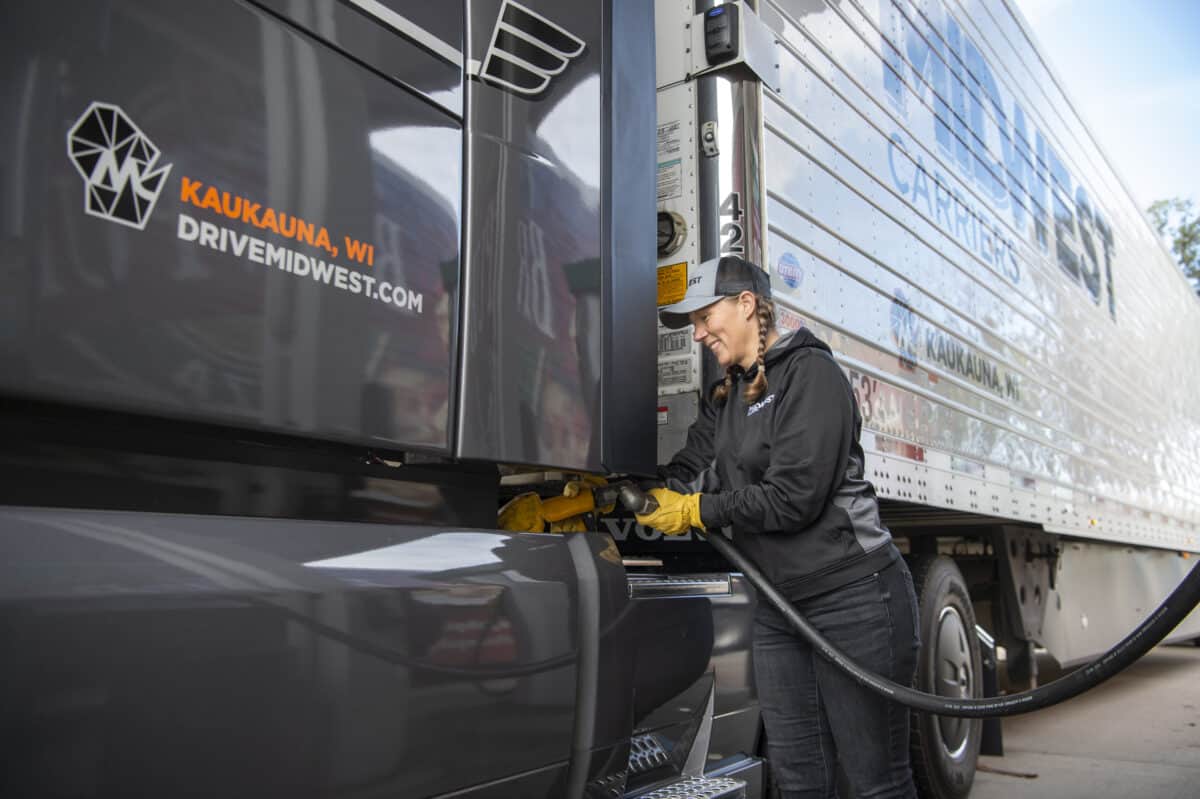As a responsible truck driver, managing the fuel economy in your truck is imperative to getting the best mpg on your trip. Your truck’s fuel economy starts before you pull off the lot. Planning your route, stops, and time it will take to get to your destination is essential in maximizing your efficiency.
On average, trucks get 6.5mpg but with attention and a bit of effort on the part of the driver, you can see upwards of 10mpg – a sizable increase! At Midwest Carriers, we incentivize our drivers to make those small changes and adjustments that make all the difference in fuel economy on the highway. Learn more about how to calculate your mpg and how our fuel economy program works at Midwest Carriers below!

Truck MPG Calculator
Understanding how to calculate miles per gallon in your truck is easy: simply divide the number of miles you drove on your last tank by the number of gallons you put in. Drivers can keep an easy logbook to check each time they fill up of how much fuel went in, and how many miles they traveled on the last tank.
Formula: Miles driven / gallons of fuel at last fill-up
Example: 1950 miles / 300 gallons of fuel = 6.5mpg
The Midwest Carriers Fuel Economy Incentive Program for OTR Drivers
At Midwest, we know everything depends on our drivers’ dedication to their work. Fuel efficiency savings would be impossible without the focused attention of our drivers every single day on the road. So, we don’t complicate our fuel economy formula with numbers that are hard to keep track of or understand. Instead, we use the same mpg formula explained in the section above. Drivers are paid per mile for fuel conservation over 7.25mpg, and compensation is tiered based on your average mpg for the month. By making quick, simple adjustments and staying aware while out on the road, our drivers can see substantial changes in their mpg and, consequently, their paychecks – our top drivers earn a Performance Bonus of up to an additional $750 a month!
Get the Least Expensive Fuel on the Route with the Midwest App
One of the best ways to stay efficient with fuel is at the pump – selecting the least expensive option in the area you are traveling can translate into big savings that add up fast. At Midwest, our drivers use the Midwest fueling station app to view and find the best prices on their route. This helps them plan ahead and stay in control of their potential savings.
Tips From Our Top MPG Drivers
1. Slow down.
Pretend there’s an egg under your fuel pedal.
Tom j.
Everyone in the trucking industry knows the best way to conserve fuel is to slow down as much as is possible and safe. It can seem like a time waster and it’s easy to want to get to the drop-off fast. But if fuel economy is a goal for you or your employer, the number one thing you can do is cut the speed and hit the cruise.
The optimal speed of a truck for maximum fuel economy is well under 65mpg.
Experts and experienced drivers debate the optimal speed for fuel savings, but the reality is there are many variables affecting the situation. Most agree, however, that by being soft with the pedal, slow to accelerate, and capping highway speed under 65mpg, you will save money and fuel. So, stay in the right lane, don’t get impatient, and settle in to save big!
Going faster doesn’t get you there much quicker.
The truth of the matter is the return isn’t worth the fuel spend. Getting to the final destination faster doesn’t justify fuel costs over 65mpg. It requires substantial changes in speed to drastically affect arrival time.
Using cruise control can increase your truck’s mpg.
Let the truck do the work.
Todd v.
It can be tempting to become less gentle with the pedal, accelerating incrementally the longer you’ve been on the road and the closer you are to the destination. Using cruise control can help avoid the “lead foot,” keeping your speed optimum and consistent.
2. Turn it off.
Turn the truck off whenever possible…every little time makes a difference.
Todd v.
Historically, many in the industry idled their trucks en route. This was costly and wasteful from a fuel perspective, but before battery-operated alternatives to keep the cabin comfortable, it was the standard operating procedure. However, the easiest way to save substantial amounts of fuel is by turning off the truck every time.
Trucks burn a gallon of fuel every hour of idle time.
The fuel savings is undeniable – roughly a gallon of fuel per hour is saved simply by turning off your truck. Calculate your current idle time and see your potential savings add up.
Roll down the windows and catch the breeze.
Most idle time is spent sleeping or waiting at the dock. We encourage drivers to prioritize comfort, but also allow nature to lend a hand. As the evening cools down, open the windows and let the fresh breeze in.
Use your battery-operated utilities when you’re parked to stay comfortable.
Most of the utilities in your cabin will operate off a battery or generator, and we encourage our drivers to take advantage of those while they’re idling. In winter, consider using your bunk heater in place of the central heat fueled by the truck’s engine. Good sleep is imperative on the road, so if you have to run the truck to stay comfortable, do so, but use other options when you can!
3. Plan ahead.
Map the most efficient route.
It seems obvious, but there are a lot of logistics to consider when planning your route, including deadlines, road closures, fuel stops, sleep…the list goes on. Simply put: planning is important. Take time to think through your plan at the beginning of each day to ensure you’re making the most of your stops.
